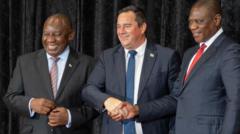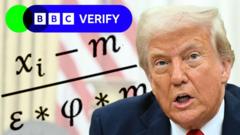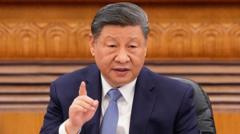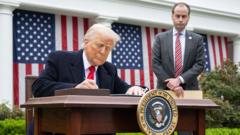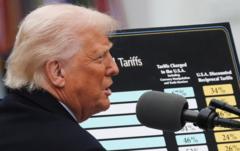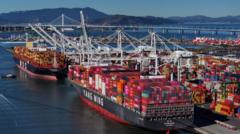As President Trump prepares to unveil sweeping new tariffs under the "Liberation Day" banner, businesses and political leaders alike are seeking clarity on the potential impact, rates, and involved countries.
Trump's 'Liberation Day' Tariffs: What Lies Ahead

Trump's 'Liberation Day' Tariffs: What Lies Ahead
A critical look into the upcoming tariffs proposed by Trump and their global implications.
With the anticipation surrounding President Donald Trump's planned announcement of new tariffs dubbed "Liberation Day," uncertainty hangs in the air. Since taking office, Trump has regularly increased tariffs on various imports, particularly targeting Chinese goods, steel, and aluminum. Recent updates suggest that further duties on automobiles are set to take effect imminently, and many are curious about the wider implications of the new tariffs that are being crafted.
The White House has yet to disclose specifics regarding the mobilization of these tariffs, leaving analysts guessing about potential rates. In the lead-up to the announcement, Trump's rhetoric has hinted at an across-the-board tariff possibly set around 10%, with some implications soaring to 60% for imports from China. The administration has also discussed the idea of reciprocal tariffs, indicating that rates could differ depending on individual countries. However, this presents a complicated structure, extending beyond mere tariffs to include unfair trade practices, such as Value Added Tax (VAT).
European officials, already on edge, are preparing for a potential double-digit tariff on their exports as they brace for Trump’s indication that goods from this region could be facing steep import taxes. Hopes for countries like the UK to remain untouched have been dashed, as Trump's recent statements hint at an inclusive strategy that may encompass all nations involved in trade with the US.
Additionally, the Trump administration has focused its targets on the so-called "Dirty 15" countries, which comprise the 15% contributing to the bulk of trade that imposes tariffs unfavorable to US businesses. These nations include Canada, the European Union, China, and several others. Interestingly, although traditionally seen as allies, nations like Canada and even the EU have garnered Trump's fiercest critique, reflecting the current administration’s tougher stance on trade.
One of the looming questions with these new tariffs is who bears the financial burden. While technically US firms importing goods will see the costs of tariffs, it's anticipated that many will find ways to minimize their exposure through alternative suppliers, cost sharing with partners, or by hiking prices for consumers. Such price increases pose the risk of dissuading buyer engagement, spiraling towards potential recession risks not only for the US but also globally, where many businesses rely on the US market.
Trump's belief that companies can sidestep tariffs by increasing domestic operations overlooks the significant challenges associated with establishing factories and hiring locally. With various global economic factors in play, including currency fluctuations and possible retaliatory actions from other nations, the fallout from Trump's bold move to recalibrate international trade remains uncertain, warranting close attention post-announcement.
The White House has yet to disclose specifics regarding the mobilization of these tariffs, leaving analysts guessing about potential rates. In the lead-up to the announcement, Trump's rhetoric has hinted at an across-the-board tariff possibly set around 10%, with some implications soaring to 60% for imports from China. The administration has also discussed the idea of reciprocal tariffs, indicating that rates could differ depending on individual countries. However, this presents a complicated structure, extending beyond mere tariffs to include unfair trade practices, such as Value Added Tax (VAT).
European officials, already on edge, are preparing for a potential double-digit tariff on their exports as they brace for Trump’s indication that goods from this region could be facing steep import taxes. Hopes for countries like the UK to remain untouched have been dashed, as Trump's recent statements hint at an inclusive strategy that may encompass all nations involved in trade with the US.
Additionally, the Trump administration has focused its targets on the so-called "Dirty 15" countries, which comprise the 15% contributing to the bulk of trade that imposes tariffs unfavorable to US businesses. These nations include Canada, the European Union, China, and several others. Interestingly, although traditionally seen as allies, nations like Canada and even the EU have garnered Trump's fiercest critique, reflecting the current administration’s tougher stance on trade.
One of the looming questions with these new tariffs is who bears the financial burden. While technically US firms importing goods will see the costs of tariffs, it's anticipated that many will find ways to minimize their exposure through alternative suppliers, cost sharing with partners, or by hiking prices for consumers. Such price increases pose the risk of dissuading buyer engagement, spiraling towards potential recession risks not only for the US but also globally, where many businesses rely on the US market.
Trump's belief that companies can sidestep tariffs by increasing domestic operations overlooks the significant challenges associated with establishing factories and hiring locally. With various global economic factors in play, including currency fluctuations and possible retaliatory actions from other nations, the fallout from Trump's bold move to recalibrate international trade remains uncertain, warranting close attention post-announcement.





